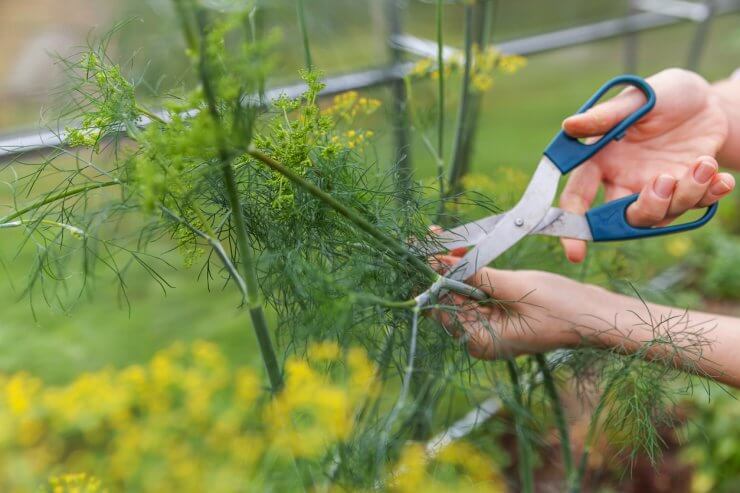
Harvesting dill with shears
You can start harvesting dill leaves once the plant is about 8 inches tall, and thereafter as you need it. Continual harvesting of leaves over the course of the growing season will result in a fuller plant and help keep the dill from bolting and going to seed early.
The best time to harvest dill is in the morning, when the plants contain more moisture and taste the best. Don’t pull the leaves; use clean, sharp scissors or snips to cut the branches. Remember, all parts of the dill plant are edible, so don’t leave the branch stems behind and feel free to pluck some of the flower heads for use in salads or garnishes in cucumber- or tomato-based drinks.
Should you cut more dill than you need, you can keep it safely in the refrigerator for two to three days after placing the stem ends in a container with water. If you have more dill than you can use over the growing season, you can dry it or freeze it. To dry, use a dehydrator or simply fan out the leaves on a piece of waxed paper on top of a cookie sheet and leave in a warm, dark place with good airflow until the dill dries out. Chop, if desired, place the dried herb in an airtight container and store in a dark place, such as a cupboard.
To freeze, assemble the leaves the same way, and place in the freezer until frozen. Once the dill has frozen, move it to an airtight container, such as a freezer bag, and return it to the freezer, using as needed.
As fall approaches, the flowers will be spent, the stems will dry out, and the seeds will turn golden brown. This is the time to harvest the seeds. If you wait until the plant dries completely and the seeds turn dark brown, the heads will release the seeds into the garden. This means you will gain volunteer dill plants the next spring, which is delightful, but you will lose the seed harvest.
To save the seeds, cut off the seed head stems and hang them head-down inside a paper bag to dry in a warm, well-ventilated area. After about two weeks, remove the heads and any fallen seeds to a tray or sheet pan and crush the head in your hands to release the remaining seeds. Separate and transfer the seeds to an airtight container and store in a dark place.
When do you harvest your dill leaves? Do you harvest the seeds? Please tell us how you harvest and store your dill.


 Previous
Previous

